http://www.iiyama.com/gb_en/products/prolite-x4071uhsu-b1/ 599euro
Does anyone know anything about this new monitor and how it compares to the Philips 40"?
This could be great with a software upgrade for freesync or even better (but unlikely) Gsync.
I loved the Philips for static use but because of the lack of any sync & noticable stutter I returned it.
My main hope is the fabled Samsung VA 100hz panel will be used soon in a Gsync/freesync monitor.
No IPS glow & VA contrast please
Does anyone know anything about this new monitor and how it compares to the Philips 40"?
This could be great with a software upgrade for freesync or even better (but unlikely) Gsync.
I loved the Philips for static use but because of the lack of any sync & noticable stutter I returned it.
My main hope is the fabled Samsung VA 100hz panel will be used soon in a Gsync/freesync monitor.
No IPS glow & VA contrast please
Last edited:
![[H]ard|Forum](/styles/hardforum/xenforo/logo_dark.png)




